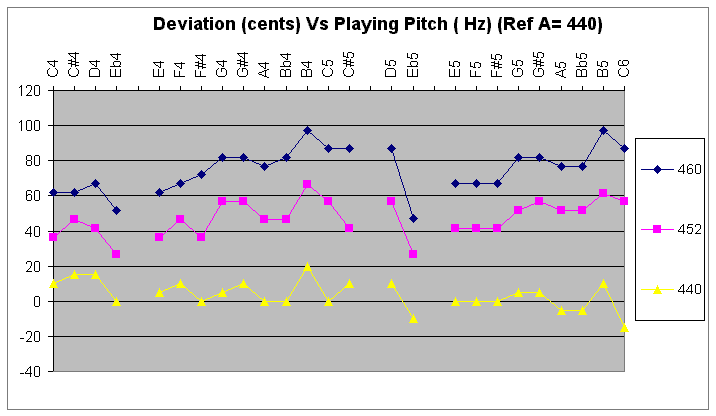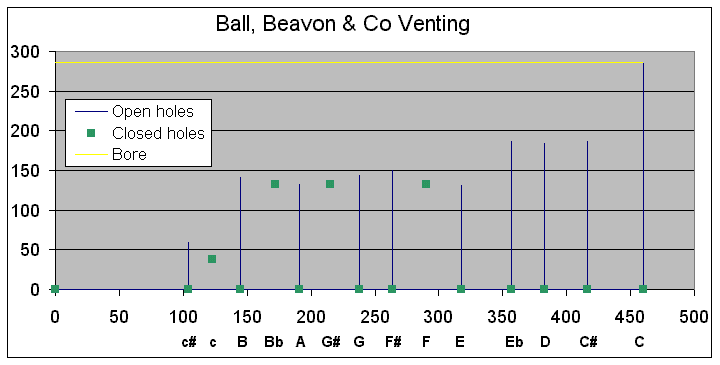Ball, Beavon & Co - a Post Boehm Cylinder FluteChaos reigned in the years immediately after Boehm released his 1847 cylinder flute. Players were torn between the old familiar fingerings of the conical and the promises of the greater accuracy with the new bore. Not surprisingly therefore, there were lot of instruments made combining both. We'll take a closer look at one version here ... Who made it?I don't know. Each part proudly bears the name Ball, Beavon and Co, the location London, and their Trade Mark, a Bee. Very into alliteration this company. We don't know much about them - the New Langwill Index has them as dealers flourishing in London between 1887 and 1917. Seems they also had outlets in Paris and Berlin and were succeeded in business by Faudel's Ltd. The only thing we know about Faudels? You guessed it - they succeeded Ball, Beavon & Co. The Bore?The bore is straight Boehm - cylindrical body and a tapering head. You can see in the image below how that is reflected in the exterior dimensions - the foot is fatter than the head. What system?Dozens of new systems of keying were thought up in those dizzy years, usually with names reflecting the names of their inventors. Pratten's Perfected, Radcliffe, Carte's 1851 and 1867 Patterns, Clinton's Equisonants, and so on. So what system does this one conform to? Surprisingly, none. Indeed it isn't a system at all, if we define a "system" as one or more keys operating on each other. All the keys on this flute (with the exception of the usual C and C# interlock) are stand-alone - they just appear to be interconnected being mounted on one long axle. What the keys do allow is greater comfort, better hole positioning and very big holes. Stretch and positioning are improved by extended touches on L3, R1 and R2. Extending R1 and R2 downwards also places the hand more conveniently to deal with the Boehm system foot. While the largest holes that can be reliably covered by the naked finger is about 11mm, holes on this flute approach 14mm on the body and exceed 15mm on the foot. As we are interested in the area of the holes, this represents an increase of around 60% on the largest hole of a large-hole 8-key, or 460% on the smallest! Playing Pitch?Ah, here's the interesting bit. Boehm was never fond of the lined head, believing it affected tone badly. When he came out with his 1832 conical, he dropped the liner and with it the regular tuning slide. This carried on to the wooden versions of the 1847 cylindrical, although a very short tuning slide was made integral with the upper tenon. This flute has such a slide. With the slide right in, A is about 460Hz - nearly a semitone sharp of modern pitch. Pulled out 8mm, about as far as it can go without becoming dangerously loose, it comes in at 452 - old High Pitch. |
Tuning?But here's the strange thing. Look at the tuning chart below:
Intonation (tuning accuracy) is distinctly less than perfect at 460Hz (in dark blue). Both octaves show considerable tilt, the foot notes are flat and the break between the octaves very messy. Things improve at 452 (pink), but the head is starting to wobble dangerously. The A440 curve (in yellow) was taken with a longer Boehm style head from another flute. Intonation at 440 is pretty good, although we can see that the foot notes are now starting to tend a little sharp. In common with a lot of the later flutes, ideal pitch is probably about 444. We can only wonder why the ideal pitch was outside the range of the tuning slide. I should add that this is not the first flute from this style and period I've found like that. Indeed, I'm not sure I've found one where this isn't the case. Why is it so?Let's look at the Venting Chart for reasons behind some of the things we've seen:
Points to observe include:
|
The EmbouchureEven when he brought out his ring-key conical in 1832, Boehm was experimenting with improved embouchure design. This continued in his 1847 cylindrical flute. These improvements did not seem to impress British makers however, and they persevered with the style of embouchure found on the 8-key flute. This head has just such an embouchure - a plain oval hole in a straight cylindrical stick. And not a big hole - 9.9 x 11.5. Compare that with the embouchure hole on the mighty conical Pratten's available at the same time - 10.7 x 12.3mm. Consequently, it's a bit unresponsive by comparison to Boehm's original and modern cylindrical flute heads. Because the flute is pitched almost a semitone high, the slight weakness in embouchure performance is well offset by the effectively higher length to diameter ratio. Subjective performancePlaying the Ball & Beavon substantiates the findings above. It's a robust flute, smooth and easy to play. Not incredibly powerful, despite the big holes. Seems that the act of covering the holes with key-plates does away with some of the gains of having the big holes. Such is life. Comfortable is the keyword, though. No difficult stretches, and keys that work smoothly and effectively right down to the lowest notes. The combination of Boehm foot and card-backed pads making the low notes readily available, unlike the awkward layout and awful pewter plugs employed on most 8-key flutes even of that time. A New HeadThe flute owner had decided on a new head for this flute, because of the High Pitch problem and as the existing head and embouchure were rather letting the flute down. For a look at the issues involved in deciding between a new head or modifying the old one, see Some "Cures" for High Pitch. You can get some idea of the differences in design from this comparison:
|

